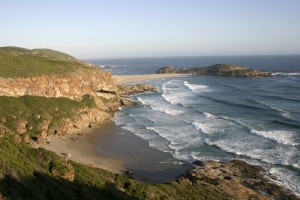LET’S be honest, the Garden Route is a misleadingly named tourist drive. If you expect clipped hedges and pretty flowerbeds, disappointment awaits. On the other hand, flamingos wade in lagoons, baboons loiter by the roadside and seals flop on dramatic shorelines. Instead of prim lawns, you get misty valleys, serrated mountain ranges and wild, isolated beaches where Antarctic waves pound. The Garden Route is magnificent, just as long as horticulture isn’t your chief interest.
Officially speaking, the Garden Route runs along 200 kilometres of South African coastline between Mossel Bay and Storms River, but for most travellers, it really means the drive of some 750 kilometres between its access points of Cape Town and Port Elizabeth. Scarcely a metre of it is less than glorious, so take at least a week, with time to explore side roads and hiking trails, or simply to relax in seaside villages.
Spectacular coastal scenery begins at Mossel Bay, but George just to the east makes a lovely first night, sitting between the coast and Outeniqua Mountains. George was described in 1811 as ‘the prettiest village in the world’ by novelist Anthony Trollope, and nothing much has changed. The town is dotted with historic buildings in the Cape Dutch and European styles of the eighteenth and nineteenth centuries.
Outside the library in York Street stands an oak tree under which slaves were once bartered, and pieces of slave chains and an old lock are still embedded in the bark in an eerie reminder of Africa’s dark past.
From here, the Garden Route leads you onwards to the upmarket seaside town of Wilderness where fine beaches meet shimmering lagoons, and spoonbills and flamingos strut. Knysna is another beautifully-located town and you could easily stop here for a few days of swimming, fishing and walking through the area’s giant yellow-wood forests.
But for something a little different, Plettenburg Bay is smaller and more elegant. The town is backed by hills of yellow-wood forest where hiking trails are a bird watcher’s delight. This chic coastal retreat also provides golf courses, fine accommodation, surfing and diving – or you can kayak on inland lakes as kingfishers flash past in neon blue flashes.
Nearby Robberg Peninsula has an 11-kilometre trail where visitors can observe seals, humpback whales and a variety of sea birds. This windswept peninsula also has shell deposits left over in middens that are remnants of the beachcombers who lived here at the time of first European settlement. From Plettenberg Bay, travellers can abandon the main highway and take the smaller R102 thoroughfare instead as it meanders through scenic gorges to Storms River Mouth.
Here, Tsitsikamma National Park preserves one of the Garden Route’s most beautiful sections of coastline where forests and river gorges combine with ocean-scapes.
The park has few roads, making hiking trails the best way to take in this natural wonder. Easy boardwalks are plentiful throughout the park, but for those up for a challenge, the five-day, 48 kilometre Otter Trail – South Africa’s most popular long walk – is simply magnificent.
The Garden Route leaves the coast at Storms River where backpackers can often be seen bungy jumping from the road bridge.
It comes to an ignominious end in the tangled highways of industrial Port Elizabeth, but visitors should not be put off. Port Elizabeth – or PE as the locals call it – hides an unexpectedly stylish city centre and splendid urban beaches.
The Garden Route is high on the must-see lists of many visitors, and with good reason. Travellers will be seduced by its natural beauty, but the key is to leave enough time to discover the quaint destinations tucked beyond the main highways that are the real hidden secret of the region.



